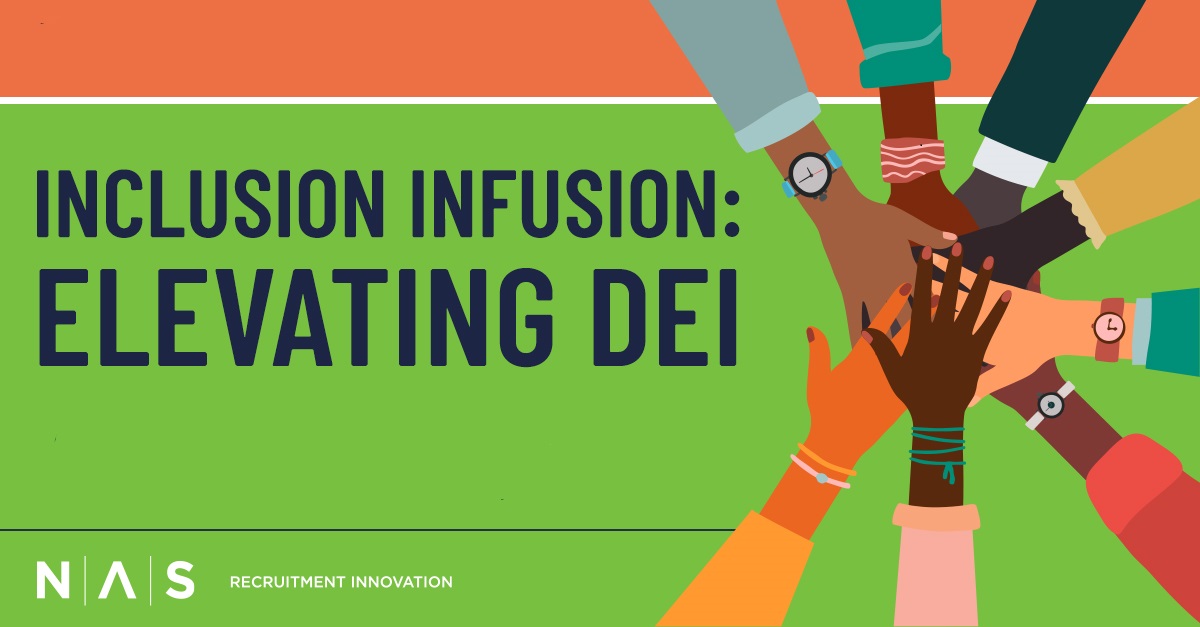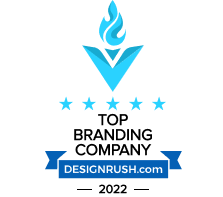-
Inclusion Infusion: Elevating DEI in your Organization
Posted by Ashley Kauffman on April 21st, 2023 
There are many important aspects to a recruiting strategy (and we can help you with all of them!), but creating a strong diversity, equity and inclusion strategy can improve your recruiting efforts significantly and even help you create a better workplace for your employees. In fact, nearly 80% of workers say that they want to work for a company that values diversity, equity and inclusion. Let’s look at the value that diversity, equity and inclusion can bring to your organization, best practices for developing a recruitment strategy that focuses on and supports diversity and inclusion and a few successful strategies to help foster and grow diversity awareness in your own organization.
DE&I Defined
Before we dive into the strategies, let’s define the individual elements of DE&I: Diversity, Equity and Inclusion.
Diversity is the representation or mix of various identities within a group. In the workplace, we often focus on specific identities such as gender, race and disability, but we all have multiple identities and ways of relating to other people.
Equity is upholding fairness and justice across all groups. Specific to the workplace, it’s all about developing policies, systems and practices that provide fair access or opportunities to as many groups as possible.
Inclusion means actively engaging, empowering and valuing all people. It requires us to consider psychological safety, respect for different lived experiences and the ability for people to share their authentic self.
When considering DEI, it’s important to ensure you’re not only focused on representation, but also equity and inclusion. If these principles aren’t present within your organization, you won’t have the benefits that come with a diverse workforce. Employees who don’t feel safe to share ideas or who don’t have equal access to opportunities are unlikely to stay with and improve your organization.
The Benefits of a DEI Effort
There are many significant benefits that will greatly impact the state of not only your recruiting, but your organization as a whole.
According to the Diversity and Inclusion (D&I) Global Market Report, diverse companies earn 2.5 times higher cash flow per employee and inclusive teams are more productive by over 35%.
The Harvard Business Review found that companies with above-average measures of the six dimensions of diversity (migration, industry, career path, gender, education, age), had both 19% points higher innovation revenues and 9% points higher EBIT margins, on average.
In a 2017 survey, Cloverpop discovered that inclusive teams make better business decisions up to 87% of the time.
Creating a DEI Centric Strategy
Create Inclusive Brand Messaging that Represents your Organization
Having a genuinely inclusive working environment is key to retaining current staff and attracting new talent, so it’s important to show your organization’s efforts through your brand messaging. When you are creating an inclusive employment brand, it’s important to remember a few key elements in this discovery process:
- Always try to recognize and understand your employees’ and candidates’ lived experiences
- Surveys can be immensely helpful to understand and learn from your employees, just be sure that these surveys reach a diverse group of people
- Gathering and incorporating feedback from your development programs or resource groups is a great tactic to ensure your brand messaging is inclusive
- Imagery plays a huge part in creating an inclusive brand, so ensure your brand images represent a wide-ranging population
Implement your Brand Messaging Externally
Sourcing Candidates
Commonly, referrals are the top source for hired candidates. It’s very likely that members of your team will have networks of people with similar backgrounds to them. Creating a diverse candidate referral program is a great way to both boost your diversity recruitment strategy and show that your company values different backgrounds and ideas. Another great way to ensure that your talent pool is full of diverse candidates is to source from a variety of places, which means you shouldn’t rely on the same sources repeatedly when seeking out new candidates. Instead, find opportunities to source diverse candidates where they feel connected. Increasing your partnership with these types of organizations, like offering internships or utilizing targeted ads, could be a great way to connect with candidates directly, instead of waiting for them to apply through sources like Indeed. The more you take the initiative to find these channels, the more likely it is that your talent pools will be diverse.
Developing Job Descriptions
Job descriptions and messaging play a big part in your external messaging as well. Complete an audit of your recruitment ads to ensure you are being inclusive and appealing to candidates from diverse backgrounds. Things to consider:
- Use inclusive language in your job descriptions to ensure they speak directly to candidates and encourage a wider pool of people to apply. Strive to avoid words that feel exclusive or carry gender bias. For help with this, Glassdoor offers 10 Ways to Remove Gender Bias from Job Descriptions.
- DEI statements are typically in the bottom boilerplate information of company descriptions, but they should be near the top to emphasize the importance of DEI within your organization.
- Include a statement on your job postings that welcomes candidates from all backgrounds and encourages applications from communities that may be historically underrepresented.
Creating a Career Site
Having diverse representation on your career site is critical. Your career site represents your organization and is the top source that candidates go to for information. Organizations can highlight their commitment to diversity in a few ways, but having a dedicated DEI page is a great place to start. This is where you can highlight your employee resource groups and existing partnerships to bring your inclusive focus to life.

Develop a Diversity Scorecard
A diversity scorecard provides an organization with a way to keep track of its metrics and to track progress. Each organization’s scorecard will look different depending on the metrics they choose. To help design your scorecard, ask yourself “why does the organization want to create a diverse and inclusive workplace?” Your answer can help you identify what metrics would be appropriate for you to measure. For example, if your focus is purely profitability driven, then looking at ROI numbers compared to the organization’s workforce and creating a correlation between the two should be included in your scorecard. You can also look at factors like Increased Innovation, Market Growth, Talent Retention Strategy and/or Employee Engagement.
Successful Strategies for Fostering and Growing Diversity Within Your Organization
Assess Current Level of Awareness
The first step in creating a winning strategy is to assess your current level of awareness of diversity and inclusion within your organization. Anonymous surveys are a great way to get a pulse on the understanding of diversity within your organization and DEI in general. Anonymous surveys help people feel more comfortable answering honestly about their current level of awareness. Another great tactic is to have conversations or small group discussions with employees that have expressed interest in diversity efforts. Often, you’ll find naturally forming groups of employees within your organization that are more engaged in this topic and may already be talking about it. Leverage those employees that have expressed an interest and bring them into the conversation. Another thing that’s vitally important is to identify areas of growth. Don’t be afraid to start small.
Cultivate Belonging
As previously mentioned, employees and job seekers truly value DEI within the workplace. In fact, 76% of job seekers and employees said a diverse workforce was an important factor for them when evaluating job opportunities and companies. Although increasing your DEI numbers is an excellent goal, you also need to make sure you’re cultivating belonging within your organization. Belonging and inclusivity are two factors that cause people to stay at organizations. If you’re looking to increase your retention and recruitment, it is vital to make sure your employees and candidates feel included and like they belong. Surveys are a great place to start to get an idea of how your employees really feel. Another way to gauge your employees’ sense of belonging is to engage willing participants of marginalized groups. Approach these conversations with an open mind and a genuine desire to learn and grow. Many of the clients we work with have been designated as Great Places to Work. To earn this award, companies must have strong DEI efforts, as well as employees who feel they belong. According to Great Place to Work, there are seven ways a company can cultivate a sense of belonging in the workplace:
- Ensure leaders avoid favoritism.
- Ensure employees feel involved in business decisions.
- Provide equal and transparent access to information.
- Implement fair promotion practices.
- Recognize employees for their hard work.
- Make employees feel welcome.
- Embrace the whole human being.
Set Actionable Goals
Actionable goals will help you define, align with, or deepen the “why” for your organization. When people within your organization understand the purpose of why you are launching DEI initiatives internally, they’re more likely to engage with the effort. Before setting your first goal, ask yourself what you want to achieve and start by asking questions internally to understand your motives and desired end-state. You can then set internal goals. Some examples include:
- Developing, expanding or communicating the work of employee resource or affinity groups
- Improving employee engagement results
- Providing more resources for marginalized populations within the organization
Next, you can set your external goals. If you are unsure where to begin with external communications, look at similar companies within your industry. Check their website and social channels to see how inclusive content is distributed. Some examples of external goals include:
- Auditing external communications channels
- Ensuring external content displays the same commitment that is being fostered internally
- Aligning Talent Acquisition, Human Resources and Marketing and Communications teams
Key Takeaways
Elevating your DEI efforts can have significant impacts not only on the success of your organization’s recruiting and retention, but also on its overall profitability and productivity. As you’re looking to implement DEI strategies, here are some key takeaways to remember:
- DEI is important to an organization’s success in achieving organizational and financial goals.
- DEI strategies take many forms with various components, but communicating these is incredibly important.
- Creating a DEI scorecard can help organizations stay focused and accountable.
- Assessing organizational awareness can help build both internal and external goals.
Through our branding, technology and marketing services, NAS can help your business optimize your DEI efforts and gain quality candidates. Ready to create engaging strategies? Contact NAS today.
Ashley Kauffman
As Director of Analytics with NAS Recruitment Innovation, Ashley works closely with our clients to help them strategize on recruiting A-level talent based on data intelligence. Ashley focuses on telling a story for our clients in a way that not only validates their current strategy, but also anticipates future opportunities. Whether your goal is delivering effective employment brands, career sites and social media strategies, or comprehensive online or traditional ad campaigns, Ashley leverages her ten plus years of industry experience to achieve success and exceed client expectations.



